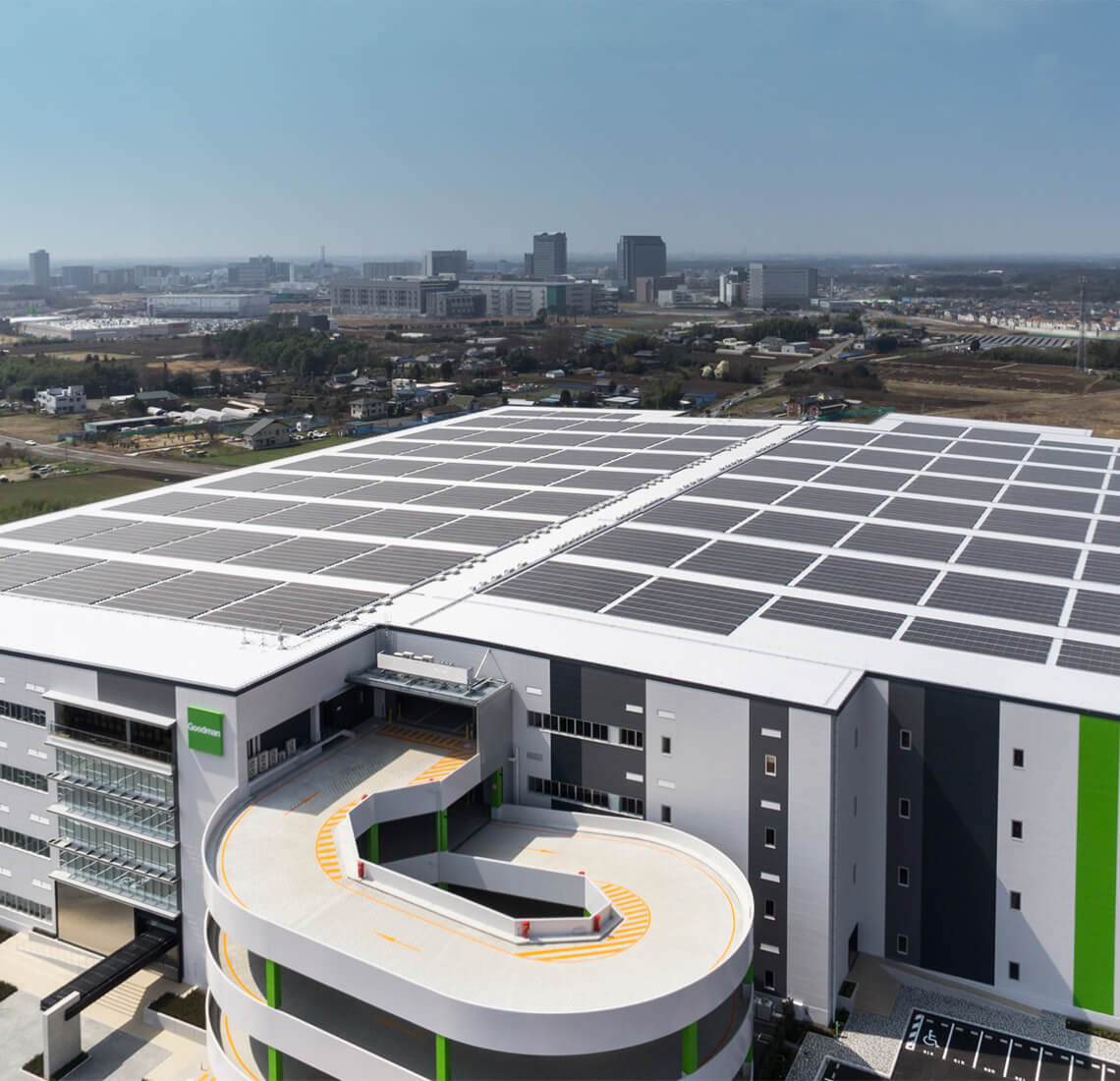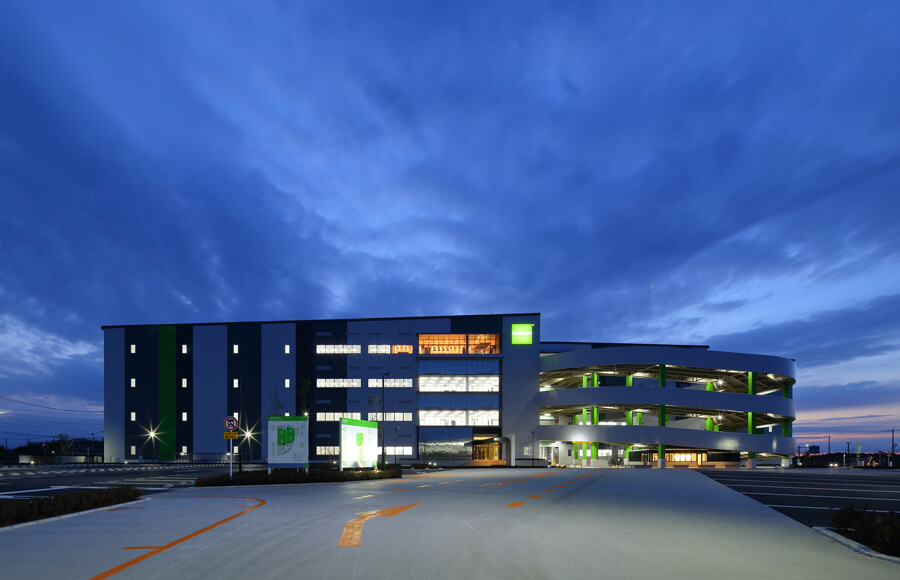PLANET
Sustainability is about more than being green. It's about building a sustainable business for the future. We do this through long-term decision-making designed to have positive economic, environmental and social outcomes.
Key to this is our responsibility to keep challenging ourselves to reduce our impact on the planet - both in our daily operations and in how we develop and manage our properties.
This section highlights some of the significant aspects of Goodman's sustainability strategy and performance in FY18.
More details are available in the annual report here.


Goodman Australia Industrial Partnership and Goodman Japan Core Partnership were FY18 GRESB sector leaders.
Benchmarking our performance
Goodman Group and several of our Investment Partnerships participate in the Global Real Estate Sustainability Benchmark (GRESB) survey to continuously review our performance.
We have succeeded in achieving consistently high scores and in 2018, all previously participating Goodman entities achieved 3 star Green Star status or above, while two Partnerships were ranked first in their respective peer groups.
In addition, Goodman uses a proprietary sustainability assessment tool for its industrial assets, the Goodman Sustainability Snapshot, which is widely used in Continental Europe and more recently in Australia.
Material issues
In the last six years, Goodman identified and refined a set of material issues fundamental to building long-term value and sustainable performance. We needed these issues to reflect not only our own principles but also our stakeholders' input.
Our sustainability strategy
Goodman's sustainability strategy is designed to make a positive long-term impact and covers the following four target areas:
- Sustainable development - continuous sustainability improvement in our developments through innovation and helping our customers evaluate and incorporate sustainable design initiatives
- Asset management - managing and investing in our assets to improve efficiency, long-term competitiveness and resilience
- Corporate performance - measuring our impact, improving our overall performance, managing our compliance obligations and engaging regularly with key stakeholders
- People and community - inspiring and challenging our people, promoting safe workplaces and supporting community groups and charities through the Goodman Foundation.
In this section, we focus on the first two target areas, particularly on how we are developing and managing assets sustainably. More information on target areas three and four is in the 'People' section.
UN Sustainable Development Goals (UNSDGs)
The UNSDGs are a global blueprint for organisations to address the world's most significant development challenges. They call for collaboration to end poverty, protect the planet and create a sustainable future for all.
We understand our role in a global sustainable future and as part of our annual strategy review and planning process we reviewed how these goals aligned with our own sustainability strategy. We found 8 of the 17 UNSDGs were relevant to our business. Significant progress on our sustainability targets was made this year.

Sustainable development
Properties built smarter are ready for the challenges of tomorrow. We are committed to high quality, reducing costs over a building's life cycle and using best practice sustainable techniques and materials. We design and build our properties with our planet in mind.
Material issues
- Our properties
- Supply chain
- Smart energy solutions
- Biodiversity
Goodman commitments
- Properties built smarter are ready for the challenges of tomorrow. We are committed to high quality, reducing costs over a building's life cycle and using best practice sustainable techniques and materials. We design and build future-proof properties with our planet in mind.
- Incorporate smart energy solutions such as renewable energy generation, LED lights and smart metering
- Partner with our supply chains to create spaces using responsible materials and means
- Maximise opportunities in infill locations
- Operate in a manner that promotes biodiversity and enhances habitat
Short-term targets
- Significant amount of new developments certified across our regions by FY19
- 10 MW of new solar PV projects completed or initiated by FY22
Progress in FY18
- Formally adopted a base-building specification for all global developments incorporating sustainability initiatives including:
- Strategic site selection close to infrastructure, consumers and transport
- Renewable energy from rooftop solar PV systems
- Translucent roof sheeting to maximise natural lighting
- Fully automated LED lights
- Electrical sub metering
- Glare control
- Low volatile organic compound materials
- Rainwater harvesting
- End-of-trip facilities
- Drought tolerant native landscaping
- 100% of Goodman's completed developments included sustainable design initiatives
- Over 7 MW of renewable energy installed or in progress in Continental Europe, Japan and Australia
- Approximately 40% of industrial space now has a certified green rating in Continental Europe
- All new developments in Continental Europe to have electric vehicle charging stations
Relevant UNSDGs


Clean energy progress
The Group's investment in solar energy infrastructure continues to gather momentum. Japan remains Goodman's primary region for the installation of solar PV on rooftops, with a further 3 MW installed at Goodman Business Park, Chiba in greater Tokyo, taking our installed capacity in Japan to approximately 19 MW. In Continental Europe, an additional 4 MW was installed last year across seven projects.
In China, the 750 kW system at Goodman Qingpu Centre in greater Shanghai is operating successfully and presents a model for several projects in planning, including a proposal for several small vertical installations on the external walls at the Goodman Pudong Airport Logistics Park.
In Australia, we are incorporating smaller systems as part of the base-building specification for the majority of new developments and beginning to retrofit solar on some existing buildings as opportunities arise.
Asset management
Our ability to manage assets through their lifecycle improves their long-term environmental and financial performance. We take a strategic view of each asset and define a clear management plan driven by location, age, capex requirements and functionality. Through this approach, we can maximise the value of our resilient and flexible portfolio to keep meeting the needs of customers into the future.
Material issues
- Customer relationships
- Resilient portfolio
- Monitoring efficiency
- Reducing waste
Goodman commitments
- Manage a high-quality portfolio, prioritising energy and water efficiency
- Manage assets and consider their current and future climate exposures
- Offer superior customer service with lease clauses that aim to reduce energy and water use
- Partner with our supply chain to promote onsite waste management and provide recycling opportunities
Short-term targets
- 1 MW of solar PV installed or initiated globally on stabilised assets in FY19
- An additional one million sqm of space upgraded to LED lighting by FY22
Progress in FY18
- LED lighting upgrades across the stabilised portfolios in Australia, Continental Europe, Hong Kong and China.
- Approximately 87% of common areas now use LED lights, reducing energy consumption by up to 60% for our China properties
- Climate Vulnerability Assessment undertaken in Australia
- 6% reduction in energy consumption across Goodman's Australian office portfolio
- Sydney head office achieved a 5 Star NABERS energy rating for the fifth consecutive year
- Water usage measures and landscaping across China properties include the re-use of rainwater, replacement of large lawns with native hedges and the use of vertical gardens to improve amenity and heat sync in summer
- Simply Cups recycling scheme in the Sydney office is saving more than 2,000 take-away cups a month from landfill
- Green lease clauses encouraged customers and Goodman to collaborate sustainably. At least one green lease clause was included in 79% of the leases signed in Continental Europe, while 63% included three clauses
Relevant UNSDGs

How do we improve?
Goodman is constantly looking to innovate and incorporate proven new technology. We investigate alternatives to existing materials and processes to enhance the long-term sustainability of our properties, and reduce our impact on the planet.
Alternatives we are evaluating include:
- Low carbon concrete products
The main element that produces carbon emissions in concrete mix, Portland cement, is significantly lower in products such as Envisia and Geopolymer Concrete. Using these can reduce emissions by an estimated 30-70%. - Lower emission steel
Products such as the carbon neutral cladding that has achieved Confidex Sustain certification which we are trialling in the UK, can reduce the carbon intensity in steel. We are also looking at alternate manufacturing processes.


Goodman Sustainability Snapshot
Goodman Sustainability Snapshot is a proprietary tool that assesses and compares the sustainability level of our buildings. The tool can be used as part of the feasibility analysis for new developments and in our detailed asset plans for our stabilised assets.
The tool helps us to:
- Identify areas with potential for sustainability improvements so we can upgrade our targets accordingly
- Improve transparency and make better investment decisions
- Improve the overall quality of our portfolio.
The tool's analysis is based on six topics (each weighted differently):
- Green certification
- Lighting
- Heating, ventilation and air conditioning (HVAC)
- Insulation
- Building management system and metering
- Features including alternative energy sources, water reuse and treatment, waste, landscaping and biodiversity, and wellbeing.
The tool, widely used in Continental Europe and more recently in Australia, is still being refined, but we're seeing some positive results. Going forward, we aim to use the insights from the Goodman Sustainability Snapshot tool to support investment in sustainability initiatives that will help improve our assets for the long-term.



